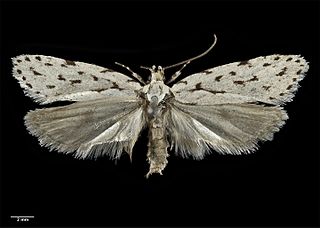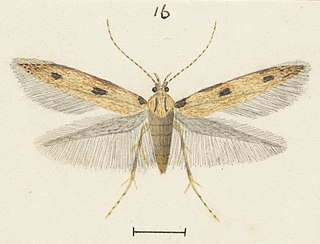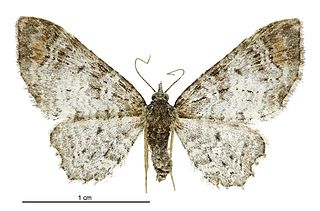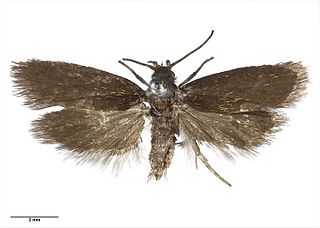
Anarsia molybdota is a species of moth of the family Gelechiidae. It is found in Australia, where it has been recorded from Queensland, Victoria, New South Wales, the Australian Capital Territory, South Australia and Western Australia.

Izatha austera is a species of moth in the family Oecophoridae. It is endemic to New Zealand. The larvae of this species feed on dead wood by tunnelling into branches of its host species. The larvae matures from September and is on the wing in the months of December to January. The adult moth is variable in colouration but is seldom observed.

Izatha psychra is a species of moth in the family Oecophoridae. It is endemic to New Zealand. It is classified as Nationally Endangered by the Department of Conservation. In 2020 it was feared that this moth was extinct as a result of a fire at the Pukaki Scientific Reserve, the last known locality of this species. However a 2021 survey found I. psychra present in the small portion of the reserve that was not damaged by the fire.

Izatha apodoxa is a moth of the family Oecophoridae. It is endemic to New Zealand, where it is known from scattered localities in the southern North Island. This species is variable in appearance and comes in two forms, a grey form and a black and white form. In the grey form it is very similar in appearance to I. notodoxa and in the black and white form to I. katadiktya. At present the larvae and biology of this species is unknown.

Izatha metadelta is a moth of the family Oecophoridae. It is endemic to New Zealand, where it is known from the North Island only. It is rare north of Waikato and the Bay of Plenty.

Izatha balanophora is a moth of the family Oecophoridae. It is endemic to New Zealand, where it is widespread in the North Island. Larvae live off the dead bark of kānuka. The adult moths are on the wing during December to March.

Izatha heroica is a moth of the family Oecophoridae. It is endemic to New Zealand, where it is widespread in the west part of the South Island. It has been collected in southern beech forests but larvae have been reared on dead kanuka or manuka bushes.

Izatha prasophyta is a moth of the family Oecophoridae. It is endemic to New Zealand, where it is known from the North Island, except Hawkes Bay or the Wairarapa. Larvae likely feed on rotting wood although larvae of this species have been reared on the fruiting body of the bracket fungus Bjerkandera adusta. Adults are on the wing from November to February.

Izatha rigescens is a species of moth in the family Oecophoridae. It is endemic to New Zealand. This species is classified as having the conservation status of "Data Deficient" by the Department of Conservation. It is only known from the Wellington coast. This species has not been seen since 1929.

Platyptilia campsiptera is a species of moth in the family Pterophoridae. This species is endemic to New Zealand. This species has been classified as Nationally Vulnerable by the Department of Conservation.

Amblyptilia epotis is a moth of the family Pterophoridae. It is endemic to New Zealand and is found in the South and Stewart Islands. It inhabits mountainous terrain covered in alpine vegetation or alternatively alpine wetland habitat. The adults of this species are on the wing from February to March. In appearance the adults of this species are variable in colour however this species can be distinguished from similar species by the oblique apical streak on its forewings as well as the patch of white on the costa cilia towards the apex of the forewing.

Labdia anarithma is a moth of the family Cosmopterigidae. It was described by Edward Meyrick in 1888. It is found in New Zealand and throughout Australia. Adults are on the wing from December to March and are day flying. They have been collected by sweeping bracken fern.

Pasiphila aristias is a species of moth in the family Geometridae. It was described by Edward Meyrick in 1897 and is endemic to New Zealand. This species is found in both the North and South Islands and inhabits subalpine and native forest. Adults are on the wing in December and January and are attracted to light.
Ardozyga lithina is a species of moth in the family Gelechiidae. It was described by Oswald Bertram Lower in 1899. It is found in Australia, where it has been recorded from New South Wales.
Ardozyga thanatodes is a species of moth in the family Gelechiidae. It was described by Oswald Bertram Lower in 1893. It is found in Australia, where it has been recorded from South Australia.
Epiphthora chionocephala is a moth of the family Gelechiidae. It was described by Oswald Bertram Lower in 1901. It is found in Australia, where it has been recorded from New South Wales.

Hierodoris squamea is a moth of the family Oecophoridae. It is endemic to New Zealand and is found in the mountains of Fiordland as well as the Olivine Range in south Westland. This species has a wingspan of between 12 and 13 mm and can be distinguished from similar species as it is very small in size, has a reduced eyespot on its forewings, clearly visible through Scanning Electron Microscope preparations, and has orange-yellow scales overlaying its dark forewing. It prefers open country of tussock grasslands and herbfields at high altitudes. As at 2005 the larvae are unknown. Adults are on the wing in January.

Tingena apanthes is a species of moth in the family Oecophoridae. It is endemic to New Zealand and found on the North Island. The adults are on the wing from October to December. It appears associated with Leptospermum species and it has been hypothesised that the appearance of the adults of this species imitates faded Leptospermum leaves.

Opsitycha squalidella is a moth of the family Oecophoridae. It was described by Edward Meyrick in 1884. This species is native to Australia and is likely adventive to New Zealand.

Trachypepla ingenua is a moth of the family Oecophoridae first described by Edward Meyrick in 1911. It is endemic to New Zealand and has been collected in both the North and South Islands. This species is one of the larger in the genus Trachypepla and the colouration of the adults imitates bird droppings. The preferred habitat of T. ingenua is native forest and adults are on the wing from December to February.


















